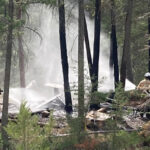Home »

Adapting to the impacts of climate change
Letter to the Editor
Raging forest fires and some of the worst air quality in the world demonstrate the Kootenay Columbia is directly experiencing devastating impacts of climate change. The federal Liberal government just released “Adapting to the Impacts of Climate Change in Canada: An update on the National Adaptation Strategy” as part of Canada’s National Adaptation Strategy.
I was part of the first round of conversations the government held to help identify the strategy’s objectives and principles. Kootenay Columbians are on the front lines. We are the ones dealing with the health effects of all that smoke, the environmental losses, the economic losses, and the deteriorating quality of life. We need ambitious solutions to adapt to the increasing impacts of climate change. We need bold action for climate resilience and a stronger economy.
The report is the beginning of a shared vision for climate change adaptation in Canada that identifies key priorities through better and increased collaboration with Canadians, various levels of government, Indigenous peoples and other key partners. The government will be launching advisory tables led by environmental organizations, adaptation experts, Indigenous Peoples, and other groups including youth from across Canada. These partners will be mandated to create a framework for concrete action, with aspirational goals, and advice on how to face climate change.
The people of the Kootenay Columbia have many creative adaptation solutions. We need to get these ideas up the pike!
Canada’s climate is warming two times faster than the global average, and three times faster in the north, according to Canada’s National Adaptation Strategy. The extreme heatwave and wildfires in Western Canada this summer underscore the urgency of adapting to climate change.
In the north, thawing permafrost is challenging traditional ways of life and infrastructure. In other parts of Canada, farmers continue to lose crops to both drought and flooding, and coastal communities are grappling with stronger storm surges and coastal erosion.
These trends clearly demonstrate the need for accelerated adaptation action alongside continued mitigation efforts. The National Adaptation Strategy will identify how best to protect Canadians. The updated Adaptation Strategy, released on August 11, is part of the strengthened climate plan, ‘A Healthy Environment and a Healthy Economy.’
A footnote: earlier this year the Liberals announced $3.79 billion in new investments related to climate change adaptation and resilience. This included investments in wildfire resilience, flood maps, health adaptation, and standards to support infrastructure resilience. A further $1.9 billion was announced in Budget 2021 to support provincial and territorial disaster response and recovery efforts.
Quick facts
Canada also submitted its first Adaptation Communication to the United Nations Framework Convention on Climate Change (UNFCCC) on July 12, 2021, in conjunction with its enhanced Nationally Determined Contribution.
• Canadians are already witnessing and experiencing the devastating impacts of climate change. In Canada’s strengthened climate plan, A Healthy Environment and a Healthy Economy, the Government of Canada committed to developing a National Adaptation Strategy.
• In this report, the Government of Canada provides an update on progress towards the release of Canada’s National Adaptation Strategy, including engagement with stakeholders and partners that began in early 2021.
• In the coming months, the Government of Canada will continue to engage with stakeholders and partners, as well as the broader public, with a view to releasing the finalized National Adaptation Strategy in fall 2022.
• The Disaster Mitigation and Adaptation Fund was allocated an additional $1.4 billion from Budget 2021 to the initial $2 billion to support projects such as wildfire mitigation activities, rehabilitation of storm water systems, and restoration of wetlands and shorelines.
• Most recently, $168.5 million was announced through the Disaster Mitigation and Adaptation Fund for the Springbank off-stream reservoir project near Calgary, which will help protect thousands of Albertans, as well as their homes, schools and local businesses, from floods on the Elbow River.
• In 2021, the Government of Canada announced $3.79 billion in new investments related to climate change adaptation and resilience. This includes $1.9 billion in Budget 2021 to support provincial and territorial disaster response and recovery efforts as well as investments in wildfire resilience, flood maps, health adaptation, and standards to support infrastructure resilience.
Robin Goldsbury,
Balfour







